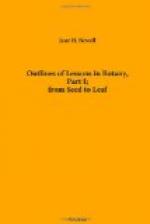[Footnote 1: Gray’s Structural Botany, Chap, iv, p. 126.]
For directions for finding the arrangement of cones,
see Gray’s Structural
Botany, Chap. IV, Sect. 1.
The subject appears easy when stated in a text-book, but, practically, it is often exceedingly difficult to determine the arrangement. Stems often twist so as to alter entirely the apparent disposition of the leaves. The general principle, however, that the leaves are disposed so as to get the best exposure to air and light is clear. This cannot be shown by the study of the naked branches merely, because these do not show the beautiful result of the distribution.[1] Many house plants can be found, which will afford excellent illustrations (Fig. 21). The Marguerite and Tobacco, both easily grown in the house, are on the 3/8 plan. The latter shows the eight ranks most plainly in the rosette of its lower leaves. The distribution is often brought about by differences in the lengths of the petioles, as in a Horsechestnut branch (Fig. 22) where the lower, larger leaves stand out further from the branch than the upper ones; or by a twist in the petioles, so that the upper faces of the leaves are turned up to the light, as in Beech (Fig. 23). If it is springtime when the lessons are given, endless adaptations can be found.
[Footnote 1: Reader in Botany. IX. Leaf-Arrangement.]
[Illustration: FIG. 21. Branch of Geranium, viewed from above.]
[Illustration: FIG. 22.]
[Illustration: FIG. 23.]
Gray’s First Lessons. Sect. IV. VII, sec. 4. How Plants Grow. Chap. I, 51-62; I, 153.
V.
STEMS.
The stem, as the scholars have already learned, is the axis of the plant. The leaves are produced at certain definite points called nodes, and the portions of stem between these points are internodes. The internode, node, and leaf make a single plant-part, and the plant is made up of a succession of such parts.
The stem, as well as the root and leaves, may bear plant-hairs. The accepted theory of plant structure assumes that these four parts, root, stem, leaves, and plant-hairs, are the only members of a flowering plant, and that all other forms, as flowers, tendrils, etc., are modified from these. While this idea is at the foundation of all our teaching, causing us to lead the pupil to recognize as modified leaves the cotyledons of a seedling and the scales of a bud, it is difficult to state it directly so as to be understood, except by mature minds. I have been frequently surprised at the failure of even bright and advanced pupils to grasp this idea, and believe it is better to let them first imbibe it unconsciously in their study. Whenever their minds are ready for it, it will be readily understood. The chief difficulty is that they imagine that there is a direct metamorphosis of a leaf to a petal or a stamen.




